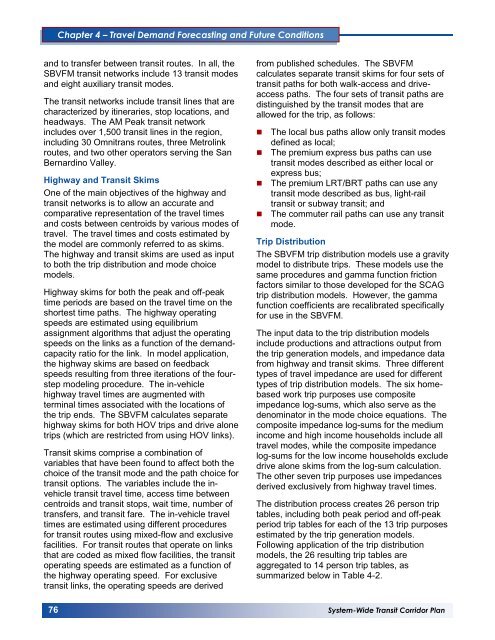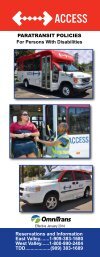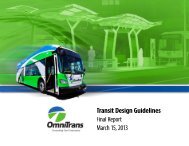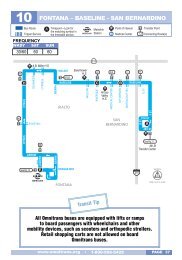New! System-Wide Transit Corridor Plan for the San ... - Omnitrans
New! System-Wide Transit Corridor Plan for the San ... - Omnitrans
New! System-Wide Transit Corridor Plan for the San ... - Omnitrans
You also want an ePaper? Increase the reach of your titles
YUMPU automatically turns print PDFs into web optimized ePapers that Google loves.
Chapter 4 – Travel Demand Forecasting and Future Conditions<br />
and to transfer between transit routes. In all, <strong>the</strong><br />
SBVFM transit networks include 13 transit modes<br />
and eight auxiliary transit modes.<br />
The transit networks include transit lines that are<br />
characterized by itineraries, stop locations, and<br />
headways. The AM Peak transit network<br />
includes over 1,500 transit lines in <strong>the</strong> region,<br />
including 30 <strong>Omnitrans</strong> routes, three Metrolink<br />
routes, and two o<strong>the</strong>r operators serving <strong>the</strong> <strong>San</strong><br />
Bernardino Valley.<br />
Highway and <strong>Transit</strong> Skims<br />
One of <strong>the</strong> main objectives of <strong>the</strong> highway and<br />
transit networks is to allow an accurate and<br />
comparative representation of <strong>the</strong> travel times<br />
and costs between centroids by various modes of<br />
travel. The travel times and costs estimated by<br />
<strong>the</strong> model are commonly referred to as skims.<br />
The highway and transit skims are used as input<br />
to both <strong>the</strong> trip distribution and mode choice<br />
models.<br />
Highway skims <strong>for</strong> both <strong>the</strong> peak and off-peak<br />
time periods are based on <strong>the</strong> travel time on <strong>the</strong><br />
shortest time paths. The highway operating<br />
speeds are estimated using equilibrium<br />
assignment algorithms that adjust <strong>the</strong> operating<br />
speeds on <strong>the</strong> links as a function of <strong>the</strong> demandcapacity<br />
ratio <strong>for</strong> <strong>the</strong> link. In model application,<br />
<strong>the</strong> highway skims are based on feedback<br />
speeds resulting from three iterations of <strong>the</strong> fourstep<br />
modeling procedure. The in-vehicle<br />
highway travel times are augmented with<br />
terminal times associated with <strong>the</strong> locations of<br />
<strong>the</strong> trip ends. The SBVFM calculates separate<br />
highway skims <strong>for</strong> both HOV trips and drive alone<br />
trips (which are restricted from using HOV links).<br />
<strong>Transit</strong> skims comprise a combination of<br />
variables that have been found to affect both <strong>the</strong><br />
choice of <strong>the</strong> transit mode and <strong>the</strong> path choice <strong>for</strong><br />
transit options. The variables include <strong>the</strong> invehicle<br />
transit travel time, access time between<br />
centroids and transit stops, wait time, number of<br />
transfers, and transit fare. The in-vehicle travel<br />
times are estimated using different procedures<br />
<strong>for</strong> transit routes using mixed-flow and exclusive<br />
facilities. For transit routes that operate on links<br />
that are coded as mixed flow facilities, <strong>the</strong> transit<br />
operating speeds are estimated as a function of<br />
<strong>the</strong> highway operating speed. For exclusive<br />
transit links, <strong>the</strong> operating speeds are derived<br />
from published schedules. The SBVFM<br />
calculates separate transit skims <strong>for</strong> four sets of<br />
transit paths <strong>for</strong> both walk-access and driveaccess<br />
paths. The four sets of transit paths are<br />
distinguished by <strong>the</strong> transit modes that are<br />
allowed <strong>for</strong> <strong>the</strong> trip, as follows:<br />
• The local bus paths allow only transit modes<br />
defined as local;<br />
• The premium express bus paths can use<br />
transit modes described as ei<strong>the</strong>r local or<br />
express bus;<br />
• The premium LRT/BRT paths can use any<br />
transit mode described as bus, light-rail<br />
transit or subway transit; and<br />
• The commuter rail paths can use any transit<br />
mode.<br />
Trip Distribution<br />
The SBVFM trip distribution models use a gravity<br />
model to distribute trips. These models use <strong>the</strong><br />
same procedures and gamma function friction<br />
factors similar to those developed <strong>for</strong> <strong>the</strong> SCAG<br />
trip distribution models. However, <strong>the</strong> gamma<br />
function coefficients are recalibrated specifically<br />
<strong>for</strong> use in <strong>the</strong> SBVFM.<br />
The input data to <strong>the</strong> trip distribution models<br />
include productions and attractions output from<br />
<strong>the</strong> trip generation models, and impedance data<br />
from highway and transit skims. Three different<br />
types of travel impedance are used <strong>for</strong> different<br />
types of trip distribution models. The six homebased<br />
work trip purposes use composite<br />
impedance log-sums, which also serve as <strong>the</strong><br />
denominator in <strong>the</strong> mode choice equations. The<br />
composite impedance log-sums <strong>for</strong> <strong>the</strong> medium<br />
income and high income households include all<br />
travel modes, while <strong>the</strong> composite impedance<br />
log-sums <strong>for</strong> <strong>the</strong> low income households exclude<br />
drive alone skims from <strong>the</strong> log-sum calculation.<br />
The o<strong>the</strong>r seven trip purposes use impedances<br />
derived exclusively from highway travel times.<br />
The distribution process creates 26 person trip<br />
tables, including both peak period and off-peak<br />
period trip tables <strong>for</strong> each of <strong>the</strong> 13 trip purposes<br />
estimated by <strong>the</strong> trip generation models.<br />
Following application of <strong>the</strong> trip distribution<br />
models, <strong>the</strong> 26 resulting trip tables are<br />
aggregated to 14 person trip tables, as<br />
summarized below in Table 4-2.<br />
132 76 <strong>System</strong>-<strong>Wide</strong> <strong>Transit</strong> <strong>Corridor</strong> <strong>Plan</strong>














